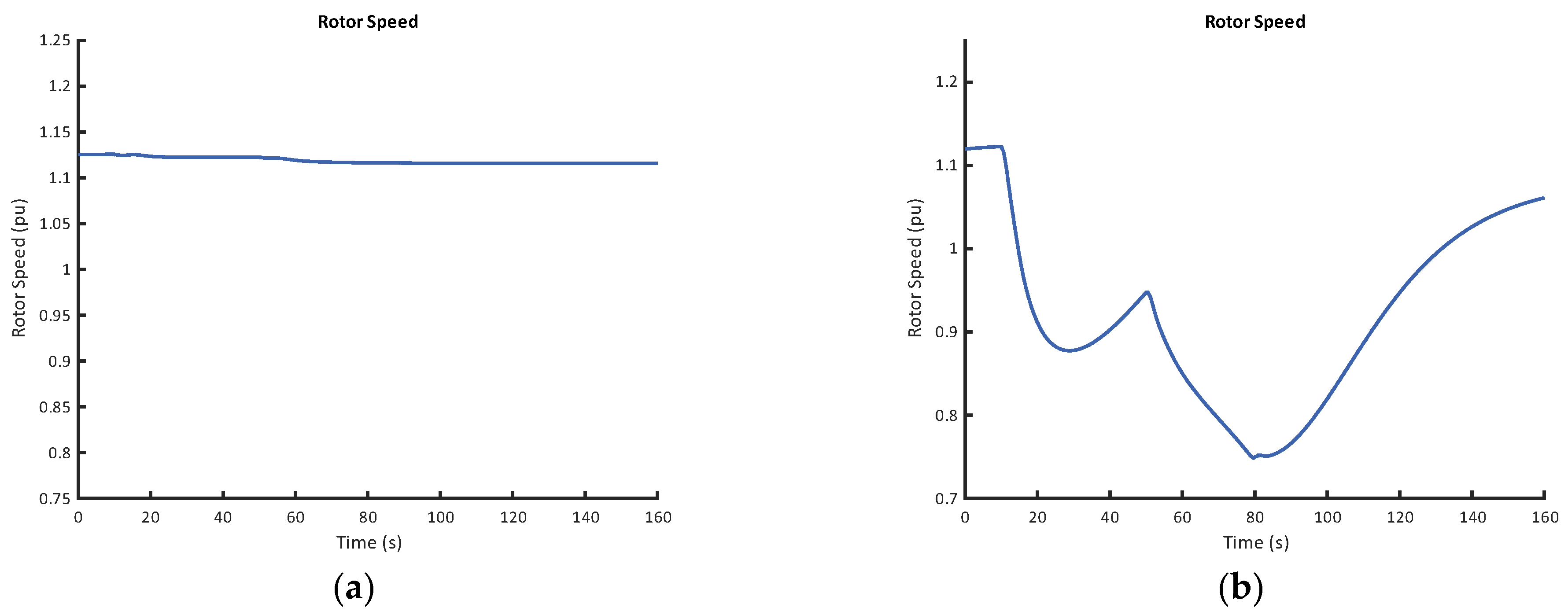Kinetic Energy Recovery of a Wind Energy Doubly-Fed Induction Generator for Grid Frequency Support †
Abstract
:1. Introduction
2. Mathematical Modeling
3. Case Study
Case Study: Wind Speed Condition of 10 m/s with a Consecutive Disturbance
4. Conclusions
Author Contributions
Funding
Institutional Review Board Statement
Informed Consent Statement
Data Availability Statement
Conflicts of Interest
References
- Musau, M.P.; Chepkania, T.L.; Odero, A.N.; Wekesa, C.W. Effects of renewable energy on frequency stability: A proposed case study of the Kenyan grid. In Proceedings of the 2017 IEEE PES-IAS PowerAfrica Conference: Harnessing Energy, Information and Communications Technology (ICT) for Affordable Electrification of Africa, PowerAfrica 2017, Accra, Ghana, 27–30 June 2017; pp. 12–15. [Google Scholar] [CrossRef]
- Ulbig, A.; Borsche, T.S.; Andersson, G. Impact of low rotational inertia on power system stability and operation. IFAC Proc. Vol. 2014, 47, 7290–7297. [Google Scholar] [CrossRef]
- Walling, R.A.; Gursoy, E.; English, B. Current contributions from Type 3 and Type 4 wind turbine generators during faults. In Proceedings of the PES T&D 2012, Orlando, FL, USA, 7–10 May 2012; pp. 1–6. [Google Scholar] [CrossRef]
- Kim, Y.-S.; Chung, I.-Y.; Moon, S.-I. An Analysis of Variable-Speed Wind Turbine Power-Control Methods with Fluctuating Wind Speed. Energies 2013, 6, 3323–3338. [Google Scholar] [CrossRef]
- Wang, Y.; Meng, J.; Zhang, X.; Xu, L. Control of PMSG-Based Wind Turbines for System Inertial Response and Power Oscillation Damping. IEEE Trans. Sustain. Energy 2015, 6, 565–574. [Google Scholar] [CrossRef]
- Boyle, J.; Littler, T.; Foley, A. Review of frequency stability services for grid balancing with wind generation. J. Eng. 2018, 2018, 1061–1065. [Google Scholar] [CrossRef]
- Xu, G.; Ge, D.; Cao, T. Combined deload and kinetic energy control of variable speed wind turbines for frequency support. In Proceedings of the 2016 IEEE PES Asia-Pacific Power and Energy Engineering Conference (APPEEC), Xi’an, China, 25–28 October 2016; pp. 890–894. [Google Scholar] [CrossRef]
- D’Arco, S.; Suul, J.A.; Fosso, O.B. A Virtual Synchronous Machine implementation for distributed control of power converters in SmartGrids. Electr. Power Syst. Res. 2015, 122, 180–197. [Google Scholar] [CrossRef]
- Fang, J.; Li, X.; Tang, Y.; Li, H. Design of virtual synchronous generators with enhanced frequency regulation and reduced voltage distortions. In Proceedings of the IEEE Applied Power Electronics Conference and Exposition—APEC, San Antonio, TX, USA, 4–8 March 2018; pp. 1412–1419. [Google Scholar] [CrossRef]
- Zheng, T.; Chen, L.; Guo, Y.; Mei, S. Comprehensive control strategy of virtual synchronous generator under unbalanced voltage conditions. IET Gener. Transm. Distrib. 2018, 12, 1621–1630. [Google Scholar] [CrossRef]
- Bhowon, A.; Abo-Al-Ez, K.M.; Adonis, M. Variable-Speed Wind Turbines for Grid Frequency Support: A Systematic Literature Review. Mathematics 2022, 10, 3586. [Google Scholar] [CrossRef]
- Kumar, T.V.; Thomas, V.; Kumaravel, S.; Ashok, S. Performance of virtual synchronous machine in autonomous mode of operation. In Proceedings of the 2018 5th International Conference on Renewable Energy: Generation and Applications (ICREGA), Al Ain, United Arab Emirates, 25–28 February 2018; pp. 310–314. [Google Scholar] [CrossRef]
- Huleihil, M.; Mazor, G. Wind Turbine Power: The Betz Limit and Beyond. In Advances in Wind Power; InTech: London, UK, 2012; p. 13. [Google Scholar] [CrossRef]
- Khurshid, A.; Mughal, M.A.; Othman, A.; Al-Hadhrami, T.; Kumar, H.; Khurshid, I.; Arshad; Ahmad, J. Optimal Pitch Angle Controller for DFIG-Based Wind Turbine System Using Computational Optimization Techniques. Electronics 2022, 11, 1290. [Google Scholar] [CrossRef]
- Yang, D.; Jin, Z.; Zheng, T.; Jin, E. An adaptive droop control strategy with smooth rotor speed recovery capability for type III wind turbine generators. Int. J. Electr. Power Energy Syst. 2022, 135, 107532. [Google Scholar] [CrossRef]
- Yang, D.; Gao, H.-C.; Zhang, L.; Zheng, T.; Hua, L.; Zhang, X. Short-term frequency support of a doubly-fed induction generator based on an adaptive power reference function. Int. J. Electr. Power Energy Syst. 2020, 119, 105955. [Google Scholar] [CrossRef]
- Chang, K.; Xue, F.; Fang, Y.; Yu, Y. Comparative simulation of dynamic characteristics of wind turbine doubly-fed induction generator based on RTDS and MATLAB. In Proceedings of the 2010 International Conference on Power System Technology: Technological Innovations Making Power Grid Smarter, POWERCON2010, Hangzhou, China, 24–28 October 2010. [Google Scholar] [CrossRef]
- Fletcher, J.; Yang, J. Introduction to the Doubly-Fed Induction Generator for Wind Power Applications, Paths to Sustainable Energy. 30 December 2010. Available online: http://www.intechopen.com/books/paths-to-sustainable-energy/introduction-to-the-doubly-fed-inductiongenerator-%0Afor-wind-power-applications (accessed on 2 December 2023).
- The MathWorks Inc. Implement Phasor Model of Variable Speed Doubly-Fed Induction Generator Driven by Wind Turbine—Simulink—MathWorks United Kingdom; The MathWorks Inc.: Natick, MA, USA, 2019; Available online: https://uk.mathworks.com/help/physmod/sps/powersys/ref/windturbinedoublyfedinductiongeneratorphasortype.html (accessed on 19 October 2019).
- The MathWorks Inc. Wind Farm—DFIG Average Model—MATLAB & Simulink—MathWorks United Kingdom; The MathWorks Inc.: Natick, MA, USA, 2022; Available online: https://uk.mathworks.com/help/physmod/sps/ug/wind-farm-dfig-average-model.html (accessed on 10 August 2022).






Disclaimer/Publisher’s Note: The statements, opinions and data contained in all publications are solely those of the individual author(s) and contributor(s) and not of MDPI and/or the editor(s). MDPI and/or the editor(s) disclaim responsibility for any injury to people or property resulting from any ideas, methods, instructions or products referred to in the content. |
© 2023 by the authors. Licensee MDPI, Basel, Switzerland. This article is an open access article distributed under the terms and conditions of the Creative Commons Attribution (CC BY) license (https://creativecommons.org/licenses/by/4.0/).
Share and Cite
Bhowon, A.; Abo-Al-Ez, K.M.; Adonis, M. Kinetic Energy Recovery of a Wind Energy Doubly-Fed Induction Generator for Grid Frequency Support. Eng. Proc. 2023, 56, 247. https://doi.org/10.3390/ASEC2023-16521
Bhowon A, Abo-Al-Ez KM, Adonis M. Kinetic Energy Recovery of a Wind Energy Doubly-Fed Induction Generator for Grid Frequency Support. Engineering Proceedings. 2023; 56(1):247. https://doi.org/10.3390/ASEC2023-16521
Chicago/Turabian StyleBhowon, Aksher, Khaled M. Abo-Al-Ez, and Marco Adonis. 2023. "Kinetic Energy Recovery of a Wind Energy Doubly-Fed Induction Generator for Grid Frequency Support" Engineering Proceedings 56, no. 1: 247. https://doi.org/10.3390/ASEC2023-16521
APA StyleBhowon, A., Abo-Al-Ez, K. M., & Adonis, M. (2023). Kinetic Energy Recovery of a Wind Energy Doubly-Fed Induction Generator for Grid Frequency Support. Engineering Proceedings, 56(1), 247. https://doi.org/10.3390/ASEC2023-16521






